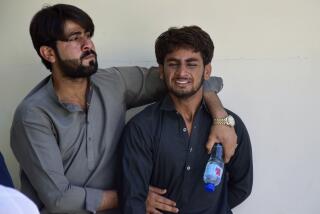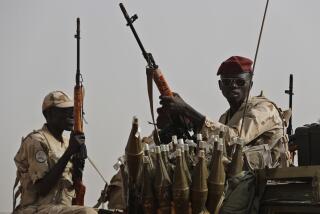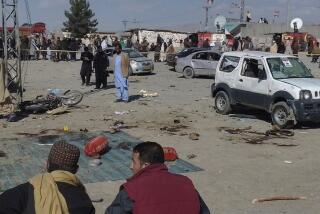Blasts kill 10 in Afghanistan
Reporting from Kabul, Afghanistan — A pair of explosions tore through a group of spectators at an illegal dogfight Sunday in southern Afghanistan, killing at least 10 people and injuring more than a dozen others in the latest in a string of deadly insurgent attacks in crowded public places.
In the last five weeks, more than 100 people, most of them civilians, have been killed in bloody assaults across the length and breadth of the country. The targets — a supermarket, a shopping mall, a bank, a wedding hall, a government records office, a sporting event — have one thing in common: people congregated there.
Officials from the North Atlantic Treaty Organization force and the Afghan government see a pattern to the killing: The Taliban and other militant groups, they say, are feeling squeezed militarily and are retaliating with a wave of urban terrorism. The violence appears intended to preempt the start of the “fighting season,” when conventional military confrontations usually intensify with the advent of warmer weather.
The sense of fear and insecurity inspired by carefully calculated attacks in populated areas undermines the Western goal of building confidence in the Afghan government and security forces, officials say. NATO’s International Security Assistance Force, the U.S. Embassy and the Afghan government have condemned the strikes, with President Hamid Karzai denouncing the latest bombings as “wicked” and un-Islamic.
The village targeted Sunday is a relatively small one, in the Arghandab district of Kandahar province. But it is not far from Kandahar city, the main hub of the country’s south, where at least 16 people were killed this month in a coordinated assault by gunmen and suicide bombers in the heart of the city.
Dogfights are banned, and police had already arrived to break this one up when the blasts occurred, apparently triggered by remote control, officials and witnesses said. Several police officers were reported to be among the dead.
In a series of assaults that began in late January with the bombing of a Western-style supermarket in Kabul, the Taliban movement has sometimes suggested that Afghan security forces, government workers or private security contractors were the primary target. But it is civilians, including women and children, who are dying in the greatest numbers; all attacks have occurred in venues where they, too, were likely to be present.
Afghans this month were sickened by grainy but graphic security-camera footage of an insurgent attack on a branch of Kabul Bank, the country’s largest private financial institution, in the eastern city of Jalalabad. The video, obtained by a popular Afghan TV network, captured gunmen cold-bloodedly shooting terrified bank patrons at close range, killing dozens.
Karzai and his government subsequently called for the death penalty for the masterminds of that attack. One of the assailants was captured.
The Taliban movement, which has claimed responsibility for most of the recent attacks, said the strike at the bank targeted Afghan security forces collecting their pay that day. But about half of those killed were ordinary bank customers.
Independent groups for some time have blamed the bulk of civilian casualties on insurgents rather than the Western military. But occasional high-profile instances of civilian deaths at the hands of the NATO force tend to lead to a greater sense of public grievance against foreign troops than the Taliban. However, the latest assaults may be changing that dynamic.
Western military officials say the Taliban sometimes claims responsibility for attacks carried out by factions, including the Haqqani network and Hezb-i-Islami, led by warlord Gulbuddin Hekmatyar. Both organizations are based in Pakistan, and in recent days, Afghan authorities have paraded captured would-be suicide bombers before the news media, prodding them to publicly recount the training and instructions they received across the frontier.
More to Read
Sign up for Essential California
The most important California stories and recommendations in your inbox every morning.
You may occasionally receive promotional content from the Los Angeles Times.










